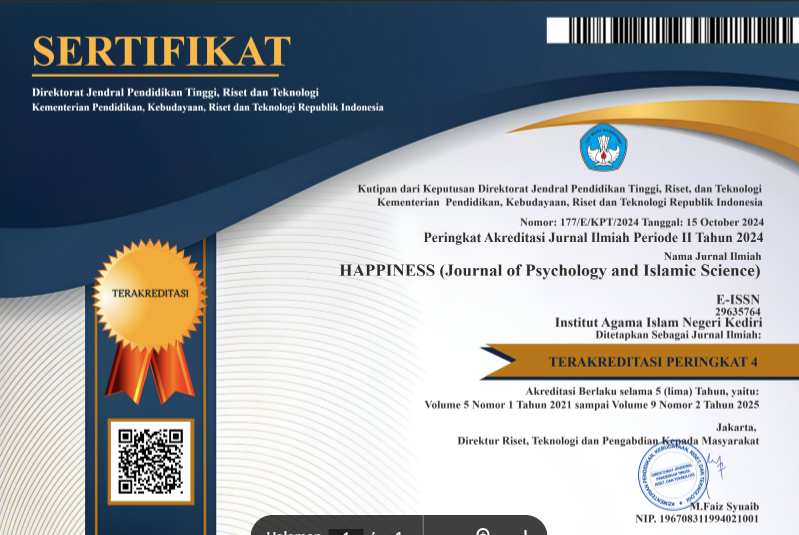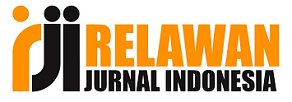Desain Intervensi Program Pembelajaran Individual (PPI) Siswa Inklusi: Studi Kasus (The Intervention Design of Individualized Education Program (IEP) for Inclusive Students: Case Study at SDN)
DOI:
https://doi.org/10.30762/happiness.v9i1.2780Keywords:
Intervention design, individualized education programs, inclusion studentsAbstract
SDN Sukorame 2 Kota Kediri as a favorite school of inclusions does not yet have individualized education program (IEP) for special-needs students, so inclusion students are treated as regular students. The IEP's goal is to help stunted abilities and tasks that are still difficult to perform. This research is aimed at digging into psychological conditions and designing for IEP interventions that match the needs of students made at SDN Sukorame 2 Kota Kediri. The methods used are qualitative case studies with the principal subjects of two inclusion students who have not yet received special services, as well as the support subjects of parents and teachers. Data is collected through interviews, observations, psychological assessment, and documentary studies. Studies indicate a difference in psychological conditions between subjects which are grouped into five aspects of development, those of cognitive, physical, language, emotional and personality development, and social. Based on these results, IEP intervention designs adapted to student conditions: the first subject with intellectual disability disorder (IDD) and nearsightedness is given the finger hold method, playing lego, and multisensory fernald; whereas the second subject with tunadaksa diagnostics is given modeling techniques, tokens economy, and giving responsibility.
Downloads
References
Aisyah, N. S. (2022). Pengentasan Self-Harm Pada Siswa SMP Negeri 10 Semarang Dengan Konseling Kelompok Teknik REBT. Counseling As Syamil, 02(1), 10–20.
Alim, R. A. S. R. (2019). Kepedulian masyarakat terhadap anak berkebutuhan khusus di lingkungan SLB Negeri B Sumedang (Studi deskriptif terhadap masyarakat di lingkungan Dusun Margamukti, Desa Licin, Kecamatan Cimalaka, Kabupaten Sumedang. JASSI Anakku, 20(2), 5–10 10 17509 19 2 22719.
Ariantini, N. S. (2020). Pengaruh relaksasi genggam jari terhadap tingkat konsentrasi siswa berkebutuhan khusus di SLB Negeri 1 Buleleng Bali. Indonesian Journal of Health Research, 3(3), 1–6. https://doi.org/10.51713/idjhr.v3i3.69
Asnaniar, W. O. S., Emin, W. S., Asfar, A., Samsualam, S., Taqiyah, Y., Marinda, N. C., Kurniawati, M., Sianu, T. H. S., & Safitri, A. S. D. (2023). Terapi relaksasi genggam jari untuk menurunkan nyeri post operasi. Martabe: Jurnal Pengabdian Masyarakat, 6(8), 2816–2822. https://doi.org/10.31604/jpm.v6i8.2816-2822
Badiah, L. I., Jauhari, M. N., & Sambira. (2020). Peningkatan keterampilan guru PAUD dalam menyusun program pembelajaran individual anak berkebutuhan khusus di PAUD Permata Bunda. Speed Journal: Journal of Special Education, 3(2), 95–100. https://doi.org/10.31537/speed.v3i2.287
Braun, V., & Clarke, V. (2006). Using thematic analysis in psychology. Qualitative Research in Psychology, 3(2), 77–101. https://doi.org/10.1191/1478088706qp063oa
Daroni, G. A. (2018). Pembelajaran Bahasa Indonesia untuk anak autis. Inklusi: Journal of Disability Studies, 5(2), 271–290. https://doi.org/10.14421/ijds.050206
Fiscus, E. D. (1983). Developing individualized education program (IEP. West Publishing Company.
Ilmiani, A. M., N., W., & Mubarak, M. R. (2021). The application of Albert Bandura’s social cognitive theory: A process in learning speaking skill. Ta’lim Al-‘Arabiyyah: Jurnal Pendidikan Bahasa Arab Dan Kebahasaaraban, 5(2), 180–192. https://doi.org/10.15575/jpba.v5i2.12945
Kusmayanti, S. (2019). Membaca permulaan dengan metode multisensori. Jurnal Pendidikan Universitas Garut, 13(1), 222–227. https://doi.org/10.52434/jp.v13i1.832
Mardiana, A., Muzakki, I., Sunaiyah, S., & Ifriqia, F. (2020). Implementasi program pembelajaran individual siswa tunagrahita kelas inklusi. Sittah: Journal of Primary Education, 1(2), 203–217. https://doi.org/10.30762/sittah.v1i2.2491
Mashudi, D. (2021). Permudah pembelajaran anak inklusi, guru di Kota Kediri kembangkan program pengembangan individual. https://surabaya.tribunnews.com/2021/06/16/permudah-pembelajaran-anak-inklusi-guru-di-kota-kediri-kembangkan-program-pengembangan-individual.
Nur’aeni. (n.d.). Buku ajar: Psikologi pendidikan anak berkebutuhan khusus. UM Purwokerto Press.
Pambudi, T., Ristiningsih, D., Jamal, A. F., & Wijayanti, M. D. (n.d.). Karawitan extracurricular as a media for mental therapy and increasing learning motivation for mentally retarded students. Social, Humanities, and Educational Studies, 7(3), 1863–1869. https://doi.org/10.20961/shes.v7i3.92321
Purba, S. A. B., Arsini, Y., & Walidaini, I. (2021). Studi literatur: Pendekatan behavioral dengan teknik modeling. Jurnal Pendidikan Tambusai, 7(3), 30593–30599. https://doi.org/10.31004/jptam.v7i3.11950
Republik Indonesia. (2003). Undang-Undang Republik Indonesia Nomor 20 Tahun 2003 tentang Sistem Pendidikan Nasional. In https://luk.staff.ugm.ac.id/atur/UU20-2003Sisdiknas.pdf: Vol. 32 ayat (1. Sekertarian Negara.
Rohman, A. A., Kusumastuti, W., & Hapsari, W. (2022). Studi kasus kepercayaan diri pada remaja tunadaksa genetik. Journal of Psychosociopreneur, 1(2), 64–69. https://jurnal.umpwr.ac.id/index.php/jpsh/article/view/3580
Rostan, N. N. A., Ismail, H., & Jaafar, A. N. M. (2021). The practice of multisensory technique towards reading skills of open syllables by preschoolers. Jurnal Pendidikan Awal Kanak-Kanak Kebangsaan, 10(1), 55–65. https://doi.org/10.37134/jpak.vol10.1.5.2021
Safitri, A., Rajiman, H., Dingomaba, L., Husain, R. R., & S, T. W. (2022). Penerapan teknik modeling untuk meningkatkan kepercayaan diri anak tunadaksa di SD Negeri 49 Kota Ternate. Jurnal Riset Dan Inovasi Pembelajaran, 2(3), 39–48. https://doi.org/10.51574/jrip.v2i3.711
Salsabilla, A. N., Kasih, F., & Nita, R. W. (2024). Designof behavioral counseling service implementation using modeling techniques to increase self confidence (Descriptive analysis studyon class XI students F S SMA PGRI 2 Padang. Educational Guidance and Counseling Development Journal, 7(1), 57–64. https://doi.org/10.24014/egcdj.v7i1.28925
Sandjaja, M. (2022). Pengaruh metode Fernald terhadap kemampuan membaca permulaan dan menulis anak tunagrahita ringan. Jurnal Pendidikan Kebutuhan Khusus, 6(1), 11–18. https://doi.org/10.24036/jpkk.v6i1.613
Santrock, J. W. (2018). Life-span development (Wisdyasinta (trans.); 13th ed.). Penerbit Erlangga.
Thani, P. K., Koohzad, N., & Ahmadi, F. (2022). Comparison of the effectiveness of Fernald’s sensory method and educational games on writing disorder in elementary school students. Advances in Bioscience and Clinical Medicine, 10(1), 1–6. https://doi.org/10.7575/aiac.abcmed.v.10n.1p.1
Tisnawati, N. R. (2020). Pengaruh Permainan lego terhadap peningkatan konsentrasi anak autis. Special and Inclusive Education Journal, 1(2), 121–137. https://core.ac.uk/download/pdf/539810377.pdf
Turnbull, A. P., Strickland, B. B., & Brantley, J. C. (1978). Developing and implementing individualized education programs. Charles E. Merril Publishing Company.
Zaqiah, R. N., Daeli, W., & Kusuma, R. (2024). Pengaruh bermain konstruksi (lego) terhadap perkembangan motorik halus pada anak pra sekolah di TK Miftahul Az-Zahra Desa Cihea Tahun 2022. Protein: Jurnal Ilmu Keperawatan Dan Kebidanan, 2(2), 88–97. https://doi.org/10.61132/protein.v2i2.237
Downloads
Published
How to Cite
Issue
Section
License
Copyright (c) 2025 Nuril Alvin Khoirur Rabaika, Prima Ayu Rizqi Mahanani, Tatik Imadatus Sa’adati

This work is licensed under a Creative Commons Attribution-ShareAlike 4.0 International License.





















